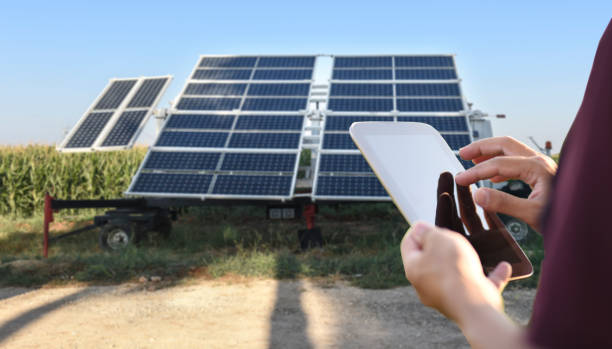
Solar energy is a significant focus for many countries. Regarding expanding PV capacities, the most pressing issue is land availability.
Massive ground-mounted power stations can be a great way to meet the rising demand for energy in a more environmentally friendly and non-polluting manner. On the other hand, these installations render large areas of arable land inaccessible.
In this constantly expanding economy, we cannot afford it!
Agrivoltaics can solve this problem. It combines both the worlds of photovoltaics and agriculture.
What is Agrivoltaics?
This term was first used in 1982 to describe the simultaneous use of land for solar energy production and agriculture. This method has increased land productivity anywhere from 35-75%.
How do these systems function?
Agrivoltaics, a relatively young technology, is implemented in many different ways. There are some similarities:
Agriculture
This land can be used to grow crops or for sheep grazing. The most common use of such systems is to grow food.
They are selected for their shading tolerance, local growing conditions, and ability to thrive in the new environment. The crops are grown between two rows of panels or under the modules.
These plants keep the surface of the panels more excellent, which in turn, increases production.
Solar Installation
Solar panels can be mounted on land to generate electricity. They can either be installed at the standard height or elevated.
This option allows the plants to receive maximum sunlight during crucial hours.
Both cases use the modules to prevent the plants from being sunburned or dehydrated. This increases food production.
Maintenance and energy generation
The water used to clean the panels drips to the plants, assisting irrigation.
The energy produced is also used to power farm equipment (tractors and pumps) along with being exported to the grid to create an additional income for the farmers.
Now that we know what it is, let’s look at the advantages of Agrivoltaics.
Agrivoltaic System: 5 Benefits
There are five main reasons why agrivoltaics is becoming more popular around the globe:
Solving 2 Problems at Once By using the same land to produce energy and food, Agrivoltaics addresses the dual problem of energy and food security.
Land resources are becoming scarce. In addition to climate change, the amount and quality of arable lands have been reduced. In this situation, deciding whether the land should be used for a PV system mounted on the ground or to grow crops isn’t easy.
Agrivoltaics allows power production and food production to coexist without competition. It increases the profitability and productivity of the land.
Solar panels can provide farmers with an additional source of income. They can sell clean energy in addition to the primary income they receive. It leads to a higher level of financial security.
Rural employment: This system is widely used in rural areas and can create PV jobs in the local community. This contributes to the development of the entire economy.
Public perception and education: Governments and private companies adopting this system educate people about sustainable agriculture and renewable energy.
They help the public understand the importance and benefits of climate-friendly agriculture.
Agrivoltaics Case Study- Cochin International Airport Ltd. (CIAL)
Cochin International Airport Ltd is the first solar-powered international airport in the world.
The organization has grown 20 different vegetables, such as yams, long-yard beans, drumsticks, mountain ginger, Turmeric, cabbage, cauliflower, and green chili. It reported a total food production of 60-80 tons per year.
CIAL can earn more revenue by establishing a direct relationship with consumers and passengers. This initiative has also improved the land, which was previously barren, by using organic fertilizers.
Agrivoltaics is India
According to MNRE, India could generate an extra 630GWp of electricity by installing solar panels on just 1% of its agricultural land. The potential for Agrivoltaics is enormous in India, as agricultural land accounts for 60% of the country’s total area.
This system is being investigated in India. NSEFI data shows that there are currently 20 agrivoltaic systems across India, with capacities ranging from 3kWp to 3MWp.
Gujarat is home to more than half of these plants.
Agrivoltaics in India can be divided into three main categories:
R&D Systems: These are research institutes or universities that have been set up to study the feasibility of agrivoltaic systems.
Government-Supported: The government developed these systems to study their functionality and integrate them into future agricultural schemes.
Commercial products: Created by private companies to generate additional revenue.
In India, the main challenges in implementing these systems are the need for more support from policymakers and the costs associated with the installation of elevated structures and maintenance. We have made significant progress since moving from R&D to commercial deployment.
